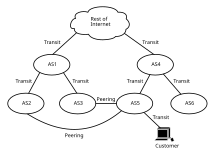Peering
The term Peering ( Engl. Peer : passu ) is defined as the union of peer computer networks for data exchange such. B. between two Internet access providers .
organization
The partners enter into a peering agreement and do not charge each other any costs.
However, it is entirely possible that a larger provider ( Tier-1 ) exchanges data with a smaller one (Tier-2), because it can either benefit from it itself or can demand money from the smaller partner for its services (paid peering) . This area has been in focus in recent years, as large service providers such as Verizon and Deutsche Telekom have been accused of artificially slowing down the exchange. A regular indirect data transfer between providers of different sizes, on the other hand, is often billed according to the amount of data and called transit .
The smallest level at which peering is used are free networks such as Freifunk . There each individual node represents a tiny provider, the connections between the nodes are peering between the providers (see Pico Peering Agreement ).
In a telephone network interconnection is called interconnection (in German: Intermediate ).
technology
The data exchange between the providers usually takes place via peering points (PP) (also known as Internet nodes ), to which a large number (several hundred) other participants can be connected. The number of possible peering agreements at an Internet node grows with the square of the number of connected participants. A table that shows all peering agreements is called a peering matrix (n * (n-1) possible entries). Routing information is exchanged via the Border Gateway Protocol (BGP).
The largest peering point in Germany is DE-CIX in Frankfurt; smaller - partly regionally oriented - points are for example ALP-IX in Munich, BCIX in Berlin, ECIX in Düsseldorf, Frankfurt, Berlin and Hamburg, N-IX in Nuremberg, S-IX in Stuttgart and WORK-IX in Hamburg.
Route server
In order to alleviate the square growth of the peering agreements, PPs also often offer Internet providers the option of peering via a "route server". This calculates the best paths for the connected routers. This is how a multilateral peering agreement comes about.
Pico Peering Agreement
The Pico Peering Agreement is an agreement that regulates the peering of community networks. The agreement stipulates that all participants offer free transit through their infrastructure. They reveal all the necessary technical details and leave the forwarded data traffic untouched. At the same time, they do not guarantee the correct operation of the services and can stop them at any time.
Web links
- This is how Internet routing works , heise.de
- Detailed English-language presentation on the subject of peering
- Peering: barter between backbone operators ( memento from October 7, 2016 in the Internet Archive )
Individual evidence
- ↑ http://www.atdn.net/peering.shtml
- ↑ Archived copy ( Memento of the original from March 4, 2016 in the Internet Archive ) Info: The archive link was inserted automatically and has not yet been checked. Please check the original and archive link according to the instructions and then remove this notice.
- ↑ http://www.atdn.net/paid_peering.shtml
- ^ Level 3 heats up the Netflix, Verizon internet war , ZDNet, July 18, 2014
- ↑ Net neutrality: Backbone operator level 3 comments on peering problems , heise Netze, September 15, 2014
- ↑ http://arstechnica.com/old/content/2008/09/peering-and-transit.ars
- ↑ German translation of the Pico Peering Agreement v1.0
